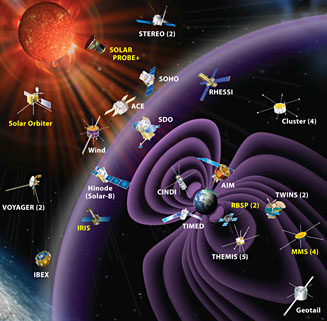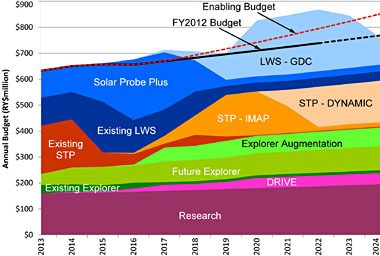A new report, titled "Solar and Space Physics: A Science for a Technological Society", provides a vision and recommendations for U.S. research in solar and space physics in the coming decade.
Think "space exploration," and you'll likely conjure up visions of rovers trundling across bleak Martian landscapes or dramatic high-speed flybys of distant comets and asteroids. When a rocket soars beyond Earth's gravitational grasp, it usually carries a payload that's headed a very specific "somewhere" in our solar system.

A score of current (white) and future (yellow) spacecraft tasked with studying the Sun and space physics — known collectively among researchers as the Heliophysics System Observatory. Click on the image for a larger version.
NASA
But an increasingly important aspect of deep-space research involves targets that are completely invisible to the human eye: the complicated mix of charged particles and electromagnetic fields that permeate interplanetary space. These flow continuously from a seething, million-mile-wide ball of incandescent plasma — the Sun — and interact with our planet in ways that are only partially understood.We've grown familiar with the term "space weather," especially in the run-up to next year's solar maximum, and we appreciate more than ever how solar storms could deal a chaotically destructive blow to our increasingly electronics-dependent civilization with little advance warning.
"Work on space-weather observations, specification, modeling, and forecasting has great societal benefit," notes Daniel N. Baker, director of the University of Colorado's Laboratory for Atmospheric and Space Physics. "It is basic research with a high public purpose."
Against this backdrop, the National Academy of Sciences has released a blueprint for U.S. research concerning the Sun and its electromagnetic environment in the coming decade. Titled "Solar and Space Physics: A Science for a Technological Society", it's the culmination of an 18-month effort, chaired by Baker, that involved nearly a 100 scientists and engineers. It's also the third major "decadal survey" dealing with space science to be released in the past couple of years, the other two having delved into astrophysics and planetary exploration.
The report lays out four goals that should drive solar and space physics in the 2013-22 time frame:
- determine the origins of the Sun’s activity and predict the variations in the space environment;
- determine the dynamics and coupling of Earth’s magnetosphere, ionosphere, and atmosphere and their response to solar and terrestrial inputs;
- determine the interaction of the Sun with the solar system and the interstellar medium; and
- discover and characterize fundamental processes that occur both within the heliosphere and throughout the universe.

How many solar and space-physics projects can the U.S. afford? The red line on this plot assumes that future budgets for NASA and NSF will be 2% above the rate of inflation, whereas the black line increases only at the rate of inflation (2.7% per year). Both might be overly optimistic.
National Academy of Sciences
As with the other decadal surveys, the new NAS report lays out a wish list of research strategies predicated on ample and growing federal funding. But that's a long shot, considering the current budgetary climate in Washington. So, while the study weights all of these goals equally, it's clear that the easiest objectives are the ones involving research close to home, either as direct probes of near-Earth space or a mix of ground- and space-based sentinels to keep a close watch on the Sun.
Most important, the study emphasizes, will be to complete projects already under way. For NASA, this means spacecraft such as the just-launched Radiation Belt Storm Probes and the forthcoming Interface Region Imaging Spectrograph (2013) and Magnetospheric Multiscale mission (2014). For the National Science Foundation, the top jobs will be completing the 4-meter-aperture Advanced Technology Solar Telescope (the world's largest) and the Advanced Modular Incoherent Scatter Radar (AMISR), a mobile observatory for studying the upper atmosphere and space-weather events.
Recognizing that monitoring the Sun and heliosphere is a complicated task, the study emphasizes the need for a new initiative called DRIVE (code for Diversify, Realize, Integrate, Venture, and Educate) that would create better coordination between NASA and NSF, with supporting roles from the National Oceanic and Atmospheric Administration (NOAA) and the Defense Department.
While the NAS report doesn't recommend specific missions per se, it does urge NASA managers to accelerate and expand the agency's Heliophysics Explorer program, a series of small- and mid-size spacecraft (in terms of cost) that have the potential to deliver high scientific return.
You can download Solar and Space Physics: A Science for a Technological Society for free at the NAS's website. The complete report is 436 pages long, so you might get all the details you need from the 33-page summary.
 2
2
Comments
Anthony Barreiro
September 11, 2012 at 1:28 pm
Thanks Kelly for another clear report on the options and recommendations for research in the coming years, and the political and budgetary outlook. There does seem to be more interest and support for solar science than for other less immediately practical areas, in large part because of the threat of "solar super storms" knocking out our GPS and electrical grid, sending us back to the dark ages. So let's keep fanning the flames of fear! But if there's a global blackout, I'll be out in the back yard with my paper sky atlas and my telescope.
You must be logged in to post a comment.
Bruce
September 22, 2012 at 9:06 am
Talk about fear mongering, "let's keep fanning the flames of fear!" Your kidding, right Anthony? While fear can be a protection (ie fear of falling, so you don't lean too far over the cliff edge) missplaced fear can lead to poor choices. A better motivator for astrophysical research is the cultivation of a love for learning, which we share and should continue to encourage in others. (I've read some of your APOD posts, so I know that your already doing this.)
I don't beleive that when "the end" comes it will be from any natural or even a manmade root cause, although natural forces will perhaps be used. For the best aplication of fear see Proverbs 12:13. ([email protected])
You must be logged in to post a comment.
You must be logged in to post a comment.